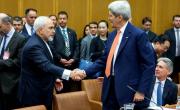Iran Can't Just Open the Oil Spigot
July 18, 2015
The biggest ripple for investors from the landmark July 14 agreement that could free Iran from international economic sanctions in return for curtailing its nuclear program will be felt in the oil markets. They didn’t take the news well. The price of Brent crude fell 2.5%, to $57.06 a barrel, from what was already close to a four-month low, before falling a bit further later in the week.
In theory, traders do have reason to fear a supply surge from a post-pariah Islamic Republic. And European oil companies such as Total (ticker: TOT), Royal Dutch Shell(RDSA.UK), Eni (ENI.Italy), and Statoil (STL.Norway), which have worked periodically in Iran despite U.S. censure, have reasons to hurry back. Iran ranks fourth in the world in energy reserves, but has fallen sharply as a producer, generating 2.77 million barrels a day last year. That’s down from 3.63 million barrels in 2011 and from the record 6.6 million before Ayatollah Khomeini’s religious revolution overthrew the Shah in 1979. Much of the recent production is used domestically and therefore never reaches global markets.
Most of Iran’s untapped petroleum riches are located onshore or in the shallow waters of the Persian Gulf, a relative cinch to drill into, compared with competing sites in the Russian Arctic or the deep ocean off the coast of Brazil. The country also controls the world’s No. 2 gas reserves, after Russia.
THE AGREEMENT, reached in Vienna by the five permanent U.N. Security Council members plus Germany and Iran’s foreign minister, Mohammad Javad Zarif, will bring these resources back into play. However, returning Iranian oil to its former glory, or even to 2011 levels, will be neither quick nor easy, say industry watchers. The reasonably well-regarded National Iranian Oil has the technical chops to restore, eventually, the million or so barrels a day in production that were lost when the last round of severe sanctions went into effect in 2012. But it won’t be able to bring more than 500,000 barrels a day back on line within six months after sanctions relief, says Andrew Slaughter, head of the Deloitte Center for Energy Solutions. The rest will take up to two years, since gas needs to be reinjected, equipment repaired, and personnel redeployed. An added one million barrels a day would increase world production by 1%, not enough to affect oil prices significantly.
Rising closer to pre-revolutionary volumes will require foreign partners. But multinationals’ experience under Islamic rule has been unhappy, and not just because of sanctions. Tehran restricted the European companies, along with Japan’s Inpex(1605.Japan) and China National Petroleum, to so-called buyback contracts. These are Big Oil’s least favorite kind of deals, because they limit compensation to costs plus a fixed margin, and don’t allow the firms to book the reserves involved on their balance sheets.

Iran’s production is less than half what it was in the 1970s (left) and it’s sitting on huge reserves (right), but upgrading production and winning back burned investors will take time.
The Iranians also harassed the investors with red tape, says Keith Crane, director of energy research at Rand Corp. “The Japanese basically threw in the towel over a lot of niggling stuff,” he says. Shell, after braving the Clinton White House’s wrath to invest $800 million in two Iranian oil fields in 1999, quietly exited from the country in 2005.
Total was Iran’s best friend in the West, signing on to pour billions into the enormous offshore South Pars gas field until politics forced it to withdraw years later. But the Paris-based giant paid a hefty price for its alleged coziness with Iranian officials. It settled a U.S. Foreign Corrupt Practices Act suit for $398 million in 2013. CEO Christophe de Margerie was threatened with criminal prosecution back home in France, but he died in a plane crash in October 2014.
China National Petroleum took over Total’s slot in 2009, putting $4.7 billion into South Pars, but had no luck with it either. After Iran’s Oil Ministry complained publicly of “many, many, many delays,” the state-controlled Chinese powerhouse bowed out of that project. Iran subsequently terminated CNPC’s involvement at a promising oil field in Azadegan.
Bijan Zanganeh, the seasoned technocrat whom reformist president Hassan Rouhani tapped as oil minister in late 2013, has been signaling to capitalists that the bad old days are over. He and his advisors have promised a new contract regime that they believe will lure some $100 billion into his sector. “We have designed a gigantic volume of investments and technical activities to produce more oil and gas,” Zanganeh announced before his global debut, at Davos, Switzerland, in 2014.
NO SPECIFICS HAVE FOLLOWED, however, and the industry is skeptical. Rouhani may well have his heart in investor-friendly reform. But as always in Iran, one must wrestle with the parallel power structures of the clerics and the Revolutionary Guard, whose unseen economic interests may be threatened in many investment areas, especially oil. (For more on stocks in Iran, see my Emerging Markets column, March 29.) “No one really knows what kind of terms they will offer,” says Gary Ross of industry consultant PIRA Energy Group. “There will be some hesitancy to rush back into Iran.”
On the other hand, oil multinationals are of necessity a forgiving lot, and most of Iran’s peers in the elite club with more than 100 billion barrels in petroleum reserves—Venezuela, Saudi Arabia, Canada, Iraq, and Kuwait—bring profound challenges of their own. Tehran certainly has a chance to regain hydrocarbon superpower status, but it will take years, not months, to tell whether the opportunity can be seized.


